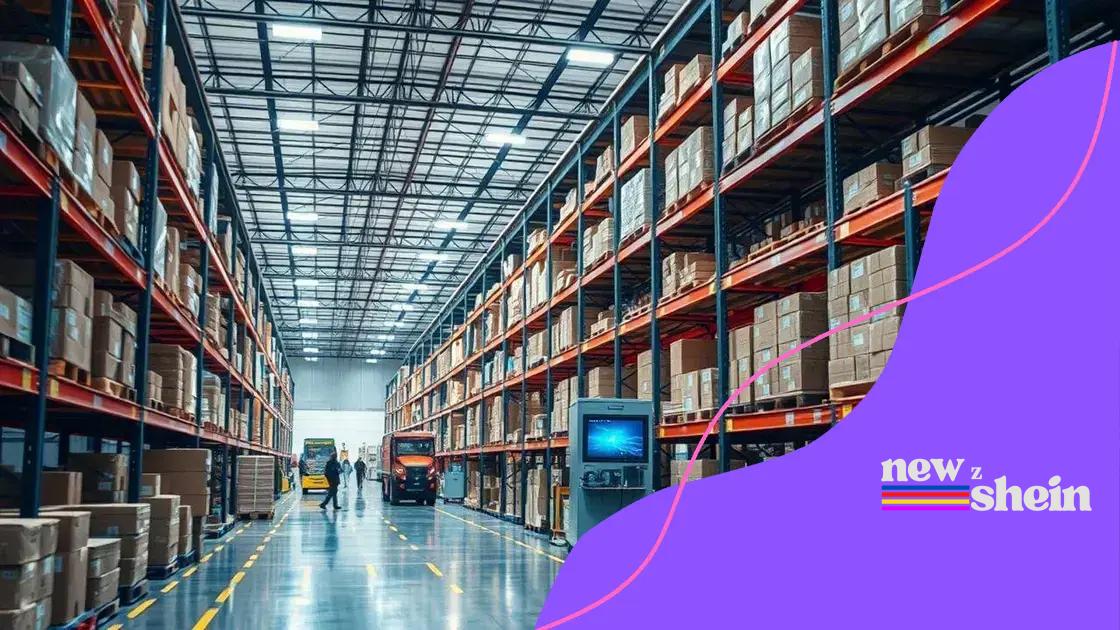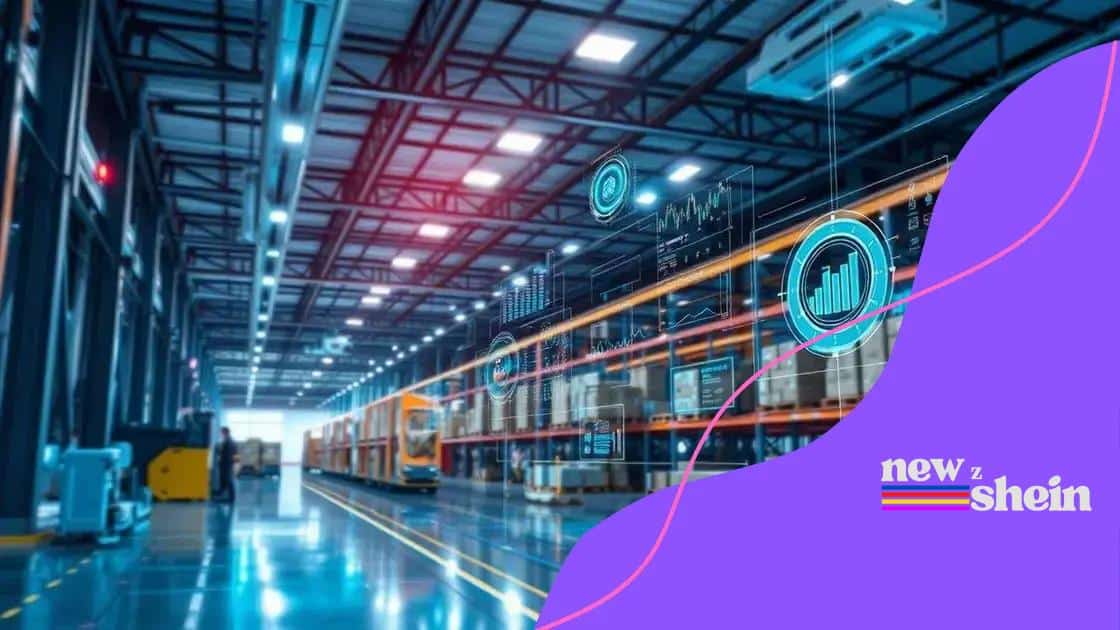Shein’s cost-effective supply chain management strategy

Shein’s cost-effective supply chain management leverages technology, data analytics, and sustainability practices to enhance efficiency, reduce costs, and quickly adapt to fashion trends while addressing challenges in logistics and inventory management.
Shein’s cost-effective supply chain management is a game-changer in the fast-fashion industry. Have you ever wondered how they quickly adapt to changing trends while keeping prices low? Let’s dive in.
Understanding Shein’s supply chain model
Understanding Shein’s supply chain model is crucial for grasping how this fast-fashion giant operates efficiently. Shein has curated a unique approach that allows them to quickly adapt to trends.
At the core of their success is a combination of advanced technology and strategic logistics. This enables Shein to produce large volumes of trendy clothing at a low cost, maintaining customer satisfaction and encouraging repeat purchases.
Key Components of Shein’s Supply Chain
The company focuses on several key components that contribute to their highly effective supply chain model.
- Trend Analysis: Shein closely monitors consumer preferences using data analytics.
- Rapid Production: With a short production cycle, they can quickly respond to emerging trends.
- Global Sourcing: Shein sources materials from various suppliers to keep costs low.
- Efficient Logistics: A streamlined logistics system ensures fast delivery to customers worldwide.
These components work together to create a seamless experience for Shein’s customers. Unlike traditional retailers, Shein can introduce new styles frequently, thanks to its agile production processes. This rapid cycle means their inventory is always fresh and relevant.
For instance, understanding market data helps predict what styles will be popular, which allows Shein to produce items before they become mainstream. This proactive approach helps capture consumer interest and drives sales.
Moreover, technology plays a significant role in managing their supply chain. Automation in warehouses and data management systems enhances efficiency, allowing Shein to coordinate resources effectively.
The Role of Technology in Supply Chain Efficiency
By leveraging cutting-edge technology, Shein can analyze trends and customer feedback instantly. This focus on tech-driven decision-making ensures that they stay ahead of the game in the fast-paced fashion world.
In summary, Shein’s supply chain model exemplifies how effective a combination of strategy and technology can be for responding to consumer demand and maximizing efficiency.
Key elements of Shein’s cost-effectiveness
The key elements of Shein’s cost-effectiveness play a vital role in their ability to offer trendy clothing at affordable prices. By focusing on specific strategies, Shein has carved out a significant niche in the fast-fashion industry.
One major aspect is their data-driven approach to fashion. Shein utilizes customer data and market trends to determine which products to produce and in what quantities. This targeted production minimizes waste and costs.
Efficient Production Processes
Shein’s production processes are finely tuned for speed and efficiency. They work closely with manufacturers who have the capability to produce garments quickly. This agile production allows them to launch new styles rapidly, keeping their inventory fresh.
- Short Lead Times: Shein can turn designs into products in days, rather than weeks.
- On-Demand Production: This reduces excess inventory and costs associated with unsold items.
- Outsourcing: Collaborating with global suppliers helps lower manufacturing costs.
In addition to their production strategies, Shein’s supply chain management enhances cost-effectiveness. By optimizing logistics and distribution, they ensure timely deliveries at reduced expenses. Their advanced technology enables real-time tracking of inventory, which helps in maintaining efficient operations.
Moreover, Shein employs targeted marketing strategies that are low-cost yet highly effective. Social media and influencer partnerships allow them to reach large audiences without heavy advertising expenses. This method appeals directly to their target demographic, driving sales and brand loyalty.
Bulk Purchasing and Cost Management
Another important factor is their ability to purchase materials in bulk, which leads to significant cost savings. This enables Shein to keep prices competitive while maintaining quality in their products.
These combined elements showcase how Shein maintains its competitive edge through innovative strategies. Their focus on data, efficiency, and cost management continues to set them apart in the fast-fashion landscape.
The role of technology in supply chain efficiency

The role of technology in supply chain efficiency is a crucial factor in Shein’s ability to meet customer demands while keeping costs low. Technology streamlines operations at every stage, making the entire process faster and more efficient.
One of the primary technologies that Shein utilizes is data analytics. This allows them to forecast trends and consumer preferences by analyzing large sets of data. With this insight, Shein can make informed decisions about what products to manufacture, reducing waste and optimizing inventory.
Automation in Warehousing
Automation plays a significant part in Shein’s logistics. Automated systems in warehouses enable quick processing and sorting of products. This helps manage stock levels efficiently and ensures that items are shipped swiftly.
- Real-Time Inventory Management: Technology helps track inventory in real time, minimizing errors and stockouts.
- Streamlined Order Processing: Automation speeds up order fulfillment, ensuring customers receive their products faster.
- Data-Driven Decisions: Analyzing sales data helps Shein adjust strategies promptly to capitalize on emerging trends.
Another technological advancement is their use of cloud computing, which enhances collaboration across teams and locations. This allows for seamless information flow, ensuring that all staff members have access to the relevant data and resources they need to perform effectively.
Additionally, Shein’s supply chain benefits from advanced communication tools. These tools foster real-time communication with suppliers and logistic partners, facilitating quicker decision-making. By maintaining clear communication, delays are minimized, and operational efficiency is maximized.
Impact of Artificial Intelligence
Artificial Intelligence (AI) is another significant game-changer for Shein. AI algorithms analyze consumer behavior and predict future purchasing patterns. This predictive capability allows Shein to tailor its offerings to consumer preferences, driving higher sales volumes.
Overall, the integration of technology in Shein’s supply chain not only enhances operational efficiency but also improves customer satisfaction by ensuring that products are available when and where they are needed. This tech-savvy approach positions Shein at the forefront of the fast-fashion industry.
Challenges faced by Shein in logistics
The challenges faced by Shein in logistics highlight the complexities of operating in the fast-fashion industry. As the company grows, it encounters unique hurdles that impact its supply chain and delivery processes.
One significant issue is managing global supply chains. With manufacturers and suppliers located worldwide, coordinating logistics becomes increasingly complicated. These complexities can lead to delays in production and shipping, which impact customer satisfaction.
Shipping Delays
Shipping delays can arise from various factors, including customs clearance and unpredictable demand. When customers expect quick delivery, any delay can lead to frustration and loss of trust.
- Customs Issues: Different countries have varying regulations that can slow down the shipping process.
- Increased Demand: During peak seasons, logistics networks can become overwhelmed, causing delays.
- Natural Disasters: Events such as hurricanes or pandemics can disrupt supply chains unexpectedly.
Another challenge is maintaining the efficiency of inventory management. With a vast range of products and constant turnover, ensuring that stock levels meet demand without overstocking can be difficult. This requires precise forecasting and flexibility.
Additionally, Shein faces competition from other fast-fashion brands. To stay ahead, they must continually refine their logistics strategies to offer quicker delivery options and better service than their rivals. This often necessitates investing in technology and infrastructure, which can be costly.
Returns Management
Returns management also poses a challenge for Shein. As a fast-fashion brand, they experience a high return rate. Managing these returns efficiently is crucial for maintaining profitability, yet it complicates logistics and inventory processes.
In light of these challenges, Shein continues to innovate in logistics. By implementing new technologies and optimizing their supply chain, they strive to improve delivery times and customer satisfaction.
Future trends in Shein’s supply chain management
The future trends in Shein’s supply chain management are poised to shape the company’s operations and overall success in the fast-fashion industry. As consumer demands evolve, so too must Shein’s strategies to remain competitive and efficient.
One key trend is the increasing reliance on advanced analytics and artificial intelligence. By utilizing AI algorithms, Shein can improve its forecasting accuracy. This allows for better inventory management and helps to predict consumer preferences more precisely, accommodating trends before they peak.
Sustainability in Supply Chain
Another significant trend is the push for sustainability in supply chain practices. More consumers are seeking eco-friendly options, compelling brands like Shein to adopt sustainable practices in sourcing and production.
- Eco-Friendly Materials: Shein is likely to increase the use of recycled and organic materials in their clothing lines.
- Carbon Footprint Reduction: Implementing strategies to lower emissions during manufacturing and shipping processes.
- Transparent Supply Chains: Providing consumers with visibility into where and how products are made.
This shift not only meets consumer demand but also helps reduce environmental impact, contributing to a more responsible business model.
Additionally, automation will play a crucial role in the future of Shein’s logistics. As technology advances, Shein can automate more aspects of its supply chain, from order fulfillment to inventory management. This will lead to even faster processing times and improved accuracy, enhancing customer satisfaction.
Expansion of Distribution Networks
As Shein continues to grow, expanding its distribution networks will be vital. Establishing more fulfillment centers globally can reduce shipping times and costs, providing a better customer experience.
This approach will also give Shein greater flexibility in responding to demand fluctuations across different regions, further solidifying its position in the industry.
Overall, these trends indicate a future where Shein continues to innovate within its supply chain, leveraging technology and sustainability to drive success and meet consumer expectations.
In conclusion, Shein’s supply chain management is a key factor in its success in the fast-fashion industry. By leveraging technology, focusing on sustainability, and adapting to consumer demands, Shein is well-positioned for future growth. The challenges it faces in logistics highlight the need for continuous innovation and improvement. Overall, Shein’s commitment to efficiency and customer satisfaction will likely lead to ongoing success.
\n\n\n
\n
\n
FAQ – Frequently Asked Questions about Shein’s Supply Chain Management
What role does technology play in Shein’s supply chain management?
Technology, including AI and automation, enhances efficiency, improves forecasting, and streamlines logistics for Shein.
How is sustainability addressed in Shein’s supply chain?
Shein is focusing on eco-friendly materials and practices to meet consumer demand for sustainable fashion.
What challenges does Shein face in logistics?
Shein encounters shipping delays, inventory management issues, and high return rates that complicate their logistics.
What future trends should Shein consider in supply chain management?
Expanding distribution networks, increasing the use of technology, and prioritizing sustainability will be key trends for Shein.





